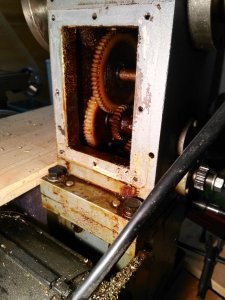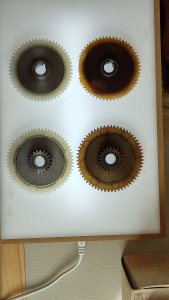About 12-13 years ago I was living in South Africa and purchased a Chinese 3 in 1 lathe, coded HQ500. Some years later I returned to the U.K. and brought it with me. It has done well for me ( very light use ) until about 1-2 years ago when the auto feed stopped and the auto feed speed change lever jammed. I continued to use it on and off without the auto feed until recently when I decided to sort it out. Examination of the manual and the machine itself did not show any reason beyond something within the headstock was broken. A query to the U.K. agents for this machine, for help in dismantling the headstock went unanswered. I therefore had to attack it blind. The first item was to drain the oil out. There is no identified oil drain plug in the manual or on the machine so finding that was guesswork. I opened up the rear panel on the headstock and, apart from oil everywhere as I had not drained it through the correct bolt, easily identified the problem. Two of the gears were plastic and one had lost some teeth--hence no drive to the auto feed. Removing the gears was relatively simple, there is only one obvious way to do it. I identified the gears and ordered replacements from the U.K. agents who responded to an order within hours! The gears were reasonably priced at £25 each but clearly had to come from China as there was a £30 airmail charge on the invoice. I decided to replace both plastic gears although only one was broken. It took nearly 5 weeks for me to receive the order so perhaps I had to wait for the manufacturers to make more stock.
I was surprised to find plastic gears within the headstock as they are not replaceable easily nor quickly as other, external, plastic gears are on other lathes are. In a previous life I was a research scientist in ICI's Plastics Division and it just so happens that the performance of Nylon ( as are the gears in my headstock ) in an oil environment was a project that I was involved in. In brief, Nylon in oil slowly looses it's strength so the failure of those gears is inevitable. Nylon should not be used in such an application.
The headstock opened showing the two nylon gears:

The two gears removed showing lost teeth on one, and their replacements:

Nigel
I was surprised to find plastic gears within the headstock as they are not replaceable easily nor quickly as other, external, plastic gears are on other lathes are. In a previous life I was a research scientist in ICI's Plastics Division and it just so happens that the performance of Nylon ( as are the gears in my headstock ) in an oil environment was a project that I was involved in. In brief, Nylon in oil slowly looses it's strength so the failure of those gears is inevitable. Nylon should not be used in such an application.
The headstock opened showing the two nylon gears:

The two gears removed showing lost teeth on one, and their replacements:

Nigel






